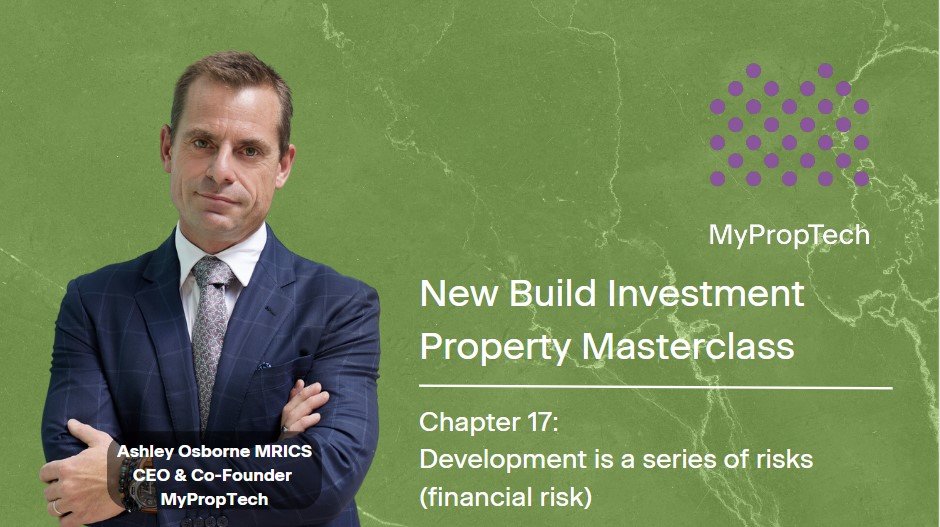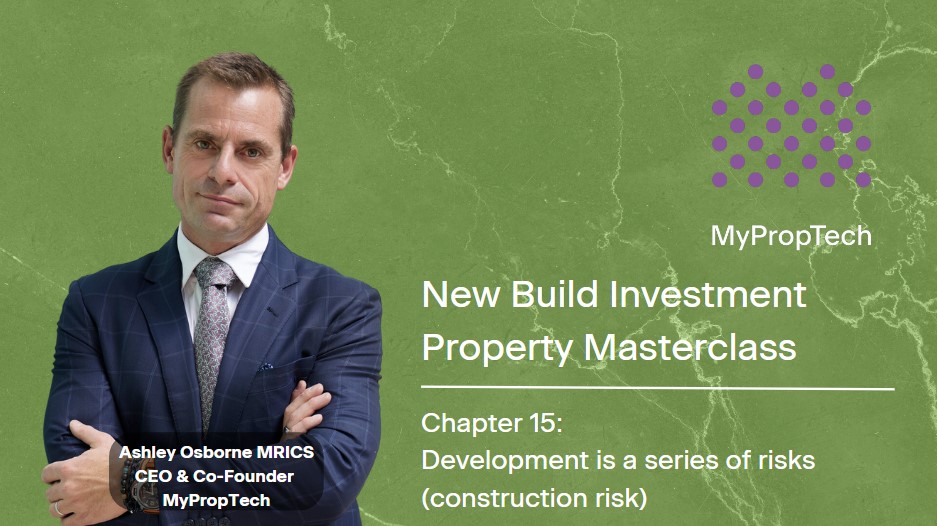New Build Investment Property Masterclass: Chapter 16 - Development is a series of risks (sales risk)
Development is a series of risks
Development is a series of risks. The developer manages these risks to deliver the development profit.
The developer's development profit is the 'GDV' less the cost of the risks associated with developing and selling the development. Think of it like this:
Gross Development Value, less
- Land risk: Cost of buying the land
- Planning risk: Cost of obtaining consent
- Construction risk: Cost of any demolition works and building a new building
- Sales risk: Cost of marketing and selling the development
- Finance risk: Cost of the capital employed for the development
= Development Profit
Sales risk
This is the risk over which you as a purchaser will have the greatest influence, and which will ultimately form part of your buying strategy. I go into considerable detail about these risks in Chapter 5: Sales and Marketing Campaigns. However, below, I explain sales risk from a developer’s perspective.
Price risk
From a sales and marketing perspective, the greatest risk that a developer faces is price risk. Real estate is an inhomogeneous product, and the market is highly inefficient. There is no set market price for each apartment, and the developer will have to make an informed decision on pricing based on market evidence.
Because the product which they are selling does not yet exist, a developer can only look at other comparable properties in the market to see how much these properties have sold for, and then draw comparisons between their proposed development and past sales to conclude what their development units might sell for - or more realistically, what range of prices they should sell for.
However, this is more challenging than you may think, as it is difficult to get information about sales values in the new-build space. This is because there is a long lag between the time a sale takes place (exchange of contracts) and the time that this sale is registered with the relevant authority, due to the timing involved in construction. Most new-build property is sold off-plan; typically it takes 18 – 24 months to build a property, and then there is usually a lag between practical completion and registering the sale.
Additionally, prices are ‘headline prices’ rather than net pricing. That is to say that the sale recorded with the relevant authority will register the time of the sale and the sale price itself. However, it will not take into account any incentives offered to the purchaser to entice them to buy. These may be contributions towards stamp duty, costs paid towards legal fees, and other items such as furniture packs that will not be registered against the transaction.
A developer relies on the following sources when developing their pricing strategy:
- Cost basis: This is the most straightforward way a developer can develop a pricing strategy, by which they simply develop a package with the known cost of the inputs, land, construction, and sales costs, then add their anticipated margin (development profit) which will deliver them a net cost (book value). They will then add a dealing margin for negotiations.
- Direct comparison: By reviewing real estate sales data, a developer will be able to build a picture of historical sales and use this information together with their interpretation of market movements (up, down, or stable) to extrapolate where their pricing should be.
- Competition: By reviewing their competition, developers will typically look at all of the competition in the market to review competing schemes and how they compare. Generally, product types are very similar, i.e. number of bedrooms, size, and features (most bathrooms and kitchens are virtually identical across all new-build stock within a given product category). So, they will most likely draw a comparison between different attributes, such as:
- Quality of specification – how does the specification compare to a competitor?
- Property Features – balconies, car parking, outside space, etc.
- Building amenities – gyms, concierge, clubhouses, etc.
- Distance to amenities relative to competitors
- Distance to public transport relative to competitors
- Distance to transport infrastructure relative to competitors
In reviewing these attributes, the developer will conclude what their pricing should be.
- Market view: Developers will also consult with property agents to determine their view of the value of the development in the open market. Developers will typically speak with many domestic, large, and small property agents who are active in that market to get their view of pricing. This will typically involve the developer sending a package of imagery and design plans to property agents and requesting their advice on how these units may be promoted, and in what price range.
However, the issue is that there is an opportunity here. The agent will be looking to be appointed by the developer to market the development. So, they are likely to overprice the development rather than talk it down.
Product risk
The building itself consists of a certain volume of apartments, accommodation types, specifications, accommodation amenities, and building amenities. If you break this down to each of the specific elements, these are not necessarily all within the overall control of the developer.
- Unit mix: A developer will decide what to develop, which will usually include a mix of one, two, three, and four-bedroom units, together with affordable housing (if required). In some markets the unit mix will be down to the developer, and they will simply take this market risk. However, in other markets such as the UK, the local authority will dictate what the unit mix will be. Before going to the market, it is virtually impossible to precisely determine how deep a market may be for a certain type of product.
- Specification: One of the easiest ways for a developer to differentiate their product in a crowded market is through specification. The specification refers to the quality of internal fittings within the building, such as the quality of tiling and sanitaryware in bathrooms, the type and quality of kitchen equipment, heating and cooling, floor coverings, window treatments, wardrobes, and more recently, the technology. There is a risk that the developer creates a specification which the market will not be willing to pay more money for, which would create obvious cost implications.
- Amenities: Amenities are used by developers to differentiate their development in a crowded market. These include accommodation-specific items such as balconies and outside space, and development-specific items such as gyms, cinema/media rooms, pools, concierges, etc. Working within the relevant development guidelines, the developer will make a series of judgments about the balance of development features and amenities required, and at what price point.

Marketing campaigning risk
From a specific development perspective, the risk to the developer occurs in several different areas:
- Incorrect price and product risk: Regardless of their sales and marketing campaign quality, if a developer cannot get buyers to believe in its pricing, then the only effective way they will have to achieve sales is to discount to meet the market.
Additionally, the developer may simply not have their product mix correct relative to the size and depth of the market. For example, a developer builds a project with an extremely high level of studio apartments, but there are simply not enough buyers for studio apartments in the market at that time. Again, the options available to the developer will become limited as they attempt to drive and achieve sales.
- Getting the market wrong: With the changing nature of global markets, developers will typically plan out detailed sales and marketing campaigns that involve releasing their project to multiple markets. In doing so, they will make assumptions about what customers in these markets are looking to purchase. In some scenarios, the developer may simply find that buyers in that market may not like the location of its project.
- Materials don’t attract the right type of buyer: Developers invest a significant amount of capital in marketing materials and sales campaigns. A common theme has been for marketing material to feature glossy images of downtown locations and amenities, which in reality are miles away from the actual location of the development, or indeed have nothing at all to do with the location of the scheme.
- Pre-sales risk: In most scenarios, the developer will need to achieve a certain pre-sales target to commence construction of the building. These targets will generally be set by lenders, and will be a pre-condition to draw down the funding used to pay contractors. Or, in the case of larger developers, they may simply need to meet internal sales targets in order to take the risk required to build.
- Timing of sales: In many scenarios, particularly for larger developers, the timing of sales will be very important. Larger listed companies will be concerned with their financial reporting, in terms of the company reports they deliver on quarterly days, their half financial year, and their end of financial year. The impact of these key metrics is important to their overall financial reports, and therefore their share price. If they cannot report positive sales results, this will impact the market perception of their financial performance.
- Campaign costs: Sales and marketing campaigns are extremely expensive (as is covered in the next section). Developers typically spend hundreds of thousands of dollars on marketing campaigns, and this can reach millions of dollars if the campaign includes international sales. If a developer spends a significant amount of money on a marketing campaign and does not achieve enough sales, this will significantly impact the overall cost of selling the development.

Market risks
Several risks also exist for developers during the sales and completion period.
- Economic risk: Sales and marketing campaigns extend over a long period, typically 12 – 18 months; larger schemes will be even longer. With the coronavirus pandemic, the UK’s Brexit referendum, the Global Financial Crisis, and other key economic events it is easy to see that significant risks can unexpectedly change the economic conditions for residential property. This may mean that developers simply have to change their marketing strategy by focusing on investors rather than owner-occupiers, or vice versa. Or, it may mean that there is no market for the product at all, in which case the developer may need to completely re-think their approach.
- Political risk: Political risk has been a major risk for developers over the past ten years. The political battle for housing has raged over this time, and investors have often been blamed for house price inflation. In response to growing calls from their constituents to respond to international and buy-to-let investors, governments have changed taxation laws several times. In the UK, the government has changed laws and introduced measures every year since 2015. This makes it very difficult to develop a long-term sales and marketing strategy.
- Completion risk: Even though purchasers are legally bound to a contract, and therefore legally obliged to complete, there is still a risk that completion will not take place. This could be for several reasons, including:
- Simply changing their mind
- Change in personal circumstances
- Change in laws
- Change in market conditions
- Inability to get a mortgage
- Customer satisfaction: This is a newly emerging and increasing risk, driven by a growing culture of Corporate Social Responsibility, consumer protection, and social media use. Development is an expensive endeavour, and accordingly, consumers are generally difficult to win over and keep happy. Developers are therefore highly protective of both their brand and perception in the market. Therefore, most large developers now have customer care teams in place to deal with and manage the risk of negative publicity, which nowadays can be amplified via the power of social media when things go wrong.
 By
By


